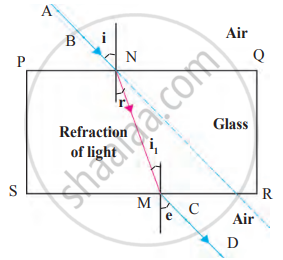Advertisements
Advertisements
Question
| Column I | Column II | Column III | |
| 1 | Dispersion | Long-sightedness | Twinkling of stars |
| 2 | Refraction | Splitting of white light into component colours | Convex lens |
| 3 | Hypermetropia | Change in the direction of the ray of light due to change in medium | Spectrum of seven colours |
Solution
| Column I | Column II | Column III | |
| 1 | Dispersion | Splitting of white light into component colours | Spectrum of seven colours |
| 2 | Refraction | Change in the direction of the ray of light due to change in medium | Twinkling of stars |
| 3 | Hypermetropia | Long-sightedness | Convex lens |
APPEARS IN
RELATED QUESTIONS
What is refraction of light?
If an object is placed at a distance of 10 cm in from of a plane mirror, how far would it be from its image?
State whether the following statement is true of false:
A student says that we can see an object because light from our eyes is reflected back by the object.
Write the word AMBULANCE as it would appear when reflected in a plane mirror. Why is it sometimes written in this way (as its mirror image) on the front of an ambulance?
What are the important differences between looking at a photograph of your face and looking at yourself in a plane mirror?
What type of reflection of light takes place from a cinema screen?
A boy with a mouth 5 cm wide stands 2 m away from a plane mirror. Where is his image and how wide is the image of his mouth?
With the help of a labelled ray-diagram, describe how a plane mirror forms an image of a point source of light placed in front of it. State the characteristics of the image formed in a plane mirror.
Explain why, though both a plane mirror and a sheet of paper reflect light but we can see the image of our face in a plane mirror but not in a sheet of paper.
An object is placed 20 cm in front of a plane mirror. The mirror is moved 2 cm towards the object. The distance between the positions of the positions of the original and final images seen in the mirror is ______.
If a ray of light goes from a rarer medium to a denser medium, will it bend towards the normal or away from it?
As light rays pass from water into glass, are they refracted towards the normal or away from the normal?
State whether the following statement is true or false:
Refraction occurs because light slows down in denser materials.
Fill in the following blank with suitable word:
Light travelling along a normal is ...............refracted.
A coin in a glass tumbler appears to rise as the glass tumbler is slowly filled with water. Name the phenomenon responsible for this effect.
Show the lateral displacement of the ray on the diagram.
State two factors on which the lateral displacement of the emergent ray depends.
Explain with the help of a labelled ray diagram, why a pencil partly immersed in water appears to be bent at the water surface. State whether the bending of pencil will increase or decrease if water is replaced by another liquid which is optically more dense than water. Give reason for your answer.
When a ray of light travelling in glass enters into water obliquely:
(a) it is refracted towards the normal
(b) it is not refracted at all
(c) it goes along the normal
(d) it is refracted away from the normal
A vertical ray of light strikes the horizontal surface of some water:
What is the angle of refraction?
The depth of a pond when seen from above appears to be less.
Light travels at a lower speed in water than in air.
Image is formed by a mirror due to refraction of light.
What do you understand by refraction of light?
What is the cause of refraction of light when it passes from one medium to another?
Define the principal focus of a concave mirror.
Light enters from air to glass having refractive index 1.50. What is the speed of light in the glass? The speed of light in vacuum is 3 × 108 m s−1.
The size of image of an object by a convex lens of focal length 20 cm is observed to be reduced to `1/3` rd of its size . Find the distance of the object from the optical centre of the lens .
Write scientific reason.
The bottom of a pond appears raised.
Observe the given figure and name the following.

| Ray AB | |
| Ray NM | |
| Ray MD | |
| ∠ r |
Assertion and reasoning type
- Assertion: If the refractive index of the medium is high (denser medium) the velocity of the light in that medium will be small
- Reason: Refractive index of the medium is inversely proportional to the velocity of the light
If a beam of red light and a beam of violet light are incident at the same angle on the inclined surface of a prism from air medium and produce angles of refraction r and v respectively, which of the following is correct?

The angle of incidence from air to glass at the point O on the hemispherical glass slab is.
How does the light travel?
Match the following:
| Column I | Column II | ||
| 1. | r > 90 | a. | Light gazes at the surface of separation between the two modes. |
| 2. | r = 90 | b. | No refraction. |
| 3. | r < 90 | c. | Refracted ray away from the normal |
